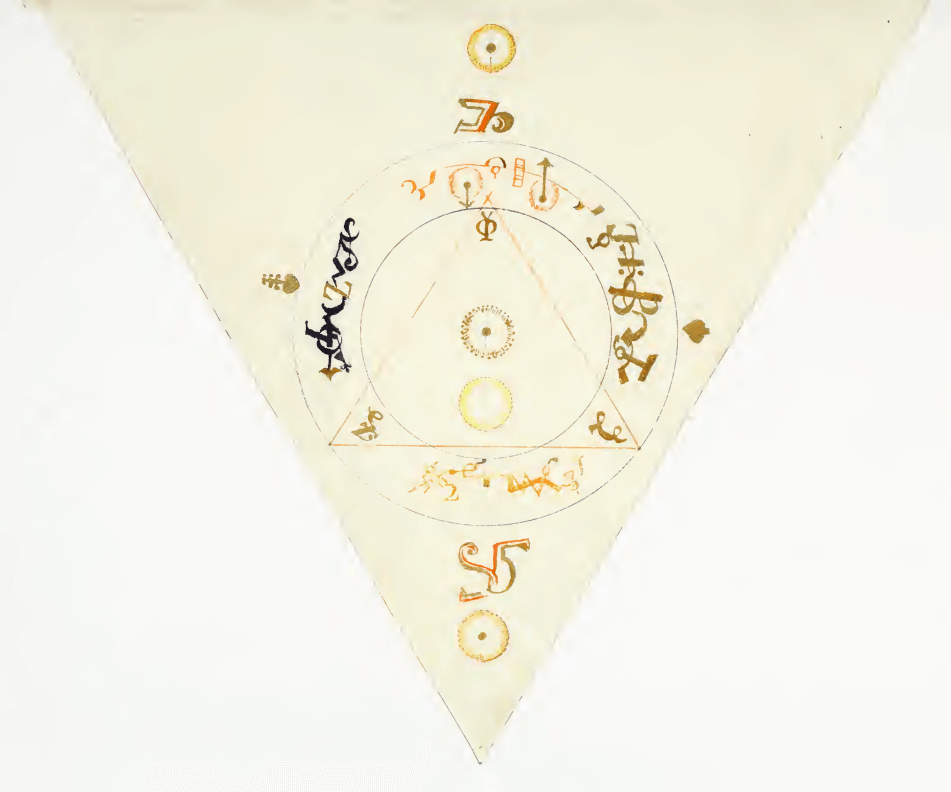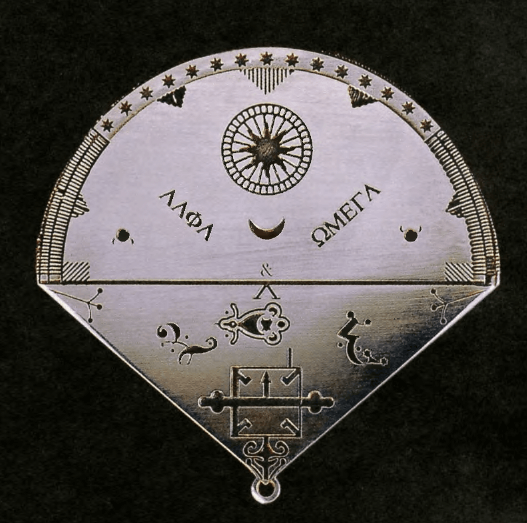The Ritual Exemplar of MS 209

The Ritual Exemplar of MS 209
Introduction: The Enigma of Saint-Germain and His Book
Among the enigmas of European esotericism, few rival the aura surrounding the Comte de Saint-Germain—the polymath, diplomat, and rumored immortal of 18th-century legend. Accounts describe him as painter, chemist, musician, and master of the “secret fire.” Yet of the many texts later attributed to him, none carries the mystery or visual perfection of MS 209, the Triangular Book of Saint-Germain, now housed in the Manly P. Hall Collection at the Getty Research Institute.
The manuscript’s triangular pages, written in gold and red ink, combine ritual, geometry, and invocation into a single seamless design. Scholars recognize it not as a working grimoire but as something rarer: a ritual exemplar—a manuscript created to embody a ceremony in flawless material form.
1. What a Ritual Exemplar Is
A ritual exemplar serves as the authoritative model of a rite. Instead of being used in the field, it is produced with absolute precision to preserve and transmit the ritual’s essence. The exemplar is the ideal form from which other copies or oral instruction originate—comparable to a temple’s cornerstone rather than its tools.
In esoteric philosophy, perfection of form was believed to invite perfection of essence. To inscribe sacred words in gold, align text with geometric proportion, and eliminate error was itself an act of consecration. The exemplar therefore performs the ritual by existing: it embodies the alchemical marriage of art and invocation.
2. Material Evidence in MS 209
Every aspect of the Triangular Book confirms this purpose.
-
Triangular folios mirror the geometry described within, where the triangle represents the union of divine, natural, and human realms.
-
Color symbolism: red for vitality and the solar principle; gold for immortality; black for the silent void between.
-
Flawless execution: no stains, revisions, or fingerprints—none of the marks that would appear on a text meant for active ceremony.
-
Luxurious binding: red morocco leather with a gilded ten-pointed star enclosing the number 76, produced by a professional Parisian binder.
Together these details show that MS 209 was never meant as a casual manual. It is a presentation copy of a higher order—one that unites liturgy, art, and cosmology into a single object of power.
3. The Spiritual Logic of Form
The exemplar’s logic reflects the Hermetic axiom as above, so below. The ritual geometry on its pages is not decorative but operative: the circle of the adept, the circle of the Levite assistant, and the triangular “figure” to be carried on the person correspond to the three aims of the operation—recovery, discovery, and renewal.
By crafting the manuscript itself in perfect proportion, the scribe enacted the same harmony the ritual sought to awaken. The Book thus becomes both text and talisman—a silent invocation of order amid the chaos of matter.
4. Role within the Saint-Germain Circle
The Triangular Book emerges from what historians now call the Saint-Germain Circle—an informal network of Masonic and Rosicrucian philosophers active in France and Central Europe between 1740 and 1790. These adepts valued alchemy as inner regeneration rather than metallurgical experiment. Within that milieu, a manuscript like MS 209 served as a symbol of initiation, displayed to candidates rather than read aloud.
The initiate would gaze upon its geometry and colors while receiving oral commentary, affirming that the “Word had become visible.” In this sense the exemplar replaced ritual performance with ritual presence: it was the ceremony crystallized in ink.
5. Why the Hand Appears Inhumanly Perfect
Modern observers often note that MS 209 seems too consistent to be handwritten. Yet analysis shows it was penned with a fine quill in 18th-century French copperplate. Such precision was achievable by professional scribes working for noble patrons, especially those versed in calligraphic geometry. Each stroke was likely measured against a compass grid drawn faintly beneath the text—a practice found in other high-grade Hermetic exemplars of the same era.
This precision was not vanity. Within the Saint-Germain current, flawless execution was itself a magical discipline—training the mind to mirror divine order.
6. Legacy and Preservation
By the time Manly P. Hall acquired the manuscript in London around 1930, it had already crossed centuries intact. Hall recognized its uniqueness immediately and described it in his correspondence as “the triangular French cipher.” Today, MS 209 remains one of the finest surviving examples of an 18th-century ritual exemplar—its pages unblemished, its geometry intact, its mystery undimmed.
Conclusion and Further Study
MS 209 continues to fascinate scholars and initiates alike because it occupies the border between art, scripture, and instrument. It is not merely a record of a magical act but the perfected body of one. In contemplating it, we glimpse how the adepts of the Saint-Germain Circle sought to fix eternity into form.
Readers may explore the complete facsimile PDF of the Triangular Book of Saint-Germain (MS 209) via the Manly P. Hall Collection, Getty Research Institute.
For expanded analyses, see companion essays on this site:
-
The Triangular Book of Saint-Germain: Ritual Geometry and the Legend of Immortality
-
Three Hands of the Triangular Book: The Living Cipher of Saint-Germain
-
The Saint-Germain Circle: Hermetic Networks of the Eighteenth Century
References & Further Reading
- Getty Research Institute, MS 209 (Manly P. Hall Collection) — digitized facsimile of The Triangular Book of Saint-Germain.
- Manly P. Hall, Secret Teachings of All Ages (Philosophical Research Society, 1928) — discussion of the Count and the Hall archive manuscripts.
- Ouroboros Press, The Triangular Book of St. Germain (2014) — commentary by Nick Koss and cipher keys.
- Waite, A.E., Collected Works on Alchemy (1893–1911) — background on ritual diagrams and concentric circles.
- Wellcome Collection, MS 4668 — study copy with French/English marginal notes.
- Bacstrom, Sigismund, Alchemical Notebooks (Inner Traditions, 2015) — parallel 18th-century ritual manuscripts.

